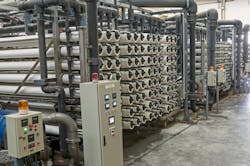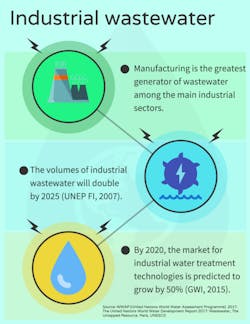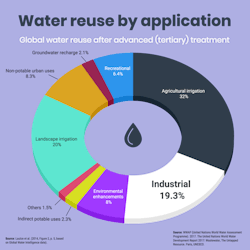Wastewater treatment technology market expected to double
The volumes of wastewater — as well as the market for industrial water treatment technologies — are both expected to rise, according to a recent report from The United Nations World Water Assessment Programme, The United Nations World Water Development Report 2017: Wastewater, The Untapped Resource, UNESCO."
Water reuse
The report discusses water reuse as a reliable alternative source of freshwater, "shifting the paradigm of wastewater management from ‘disposal’ to ‘reuse and resource recovery.’"
The graphic below shows global water reuse after advanced (tertiary) treatment. However, the report notes that, with all the wastewater produced worldwide, only a small fraction undergoes tertiary treatment.
New applications of industrial water reuse are emerging, and more efficient water recycling and process technologies can lead to the closing of the water loop in industries, according to the report. The following latest technological innovations in wastewater treatment, particularly for improving treatment efficiencies (Brdjanovic, 2015; Qu et al., 2013; Van Loosdrecht and Brdjanovic, 2014), are highlighted in the report:
Membrane filtration: Includes membrane technologies (reverse osmosis, microfiltration, ultrafiltration, etc.) for tertiary or advanced treatment, which is becoming more common.
Membrane bioreactors (MBRs): Intensifies the membrane separation by incorporating it with the activated sludge process.
Microbial fuel cells: Based on bio-electrochemical processes of bacteria.
Biological treatment processes: Examples are improved nitrogen removal and mineral crystallization processes, as well as granular sludge treatment processes using engineered microbial structures.
Nanotechnology: An emerging field in water purification and wastewater treatment, as well as in water quality and wastewater monitoring (Qu et al., 2013).
Wastewater monitoring and control systems: New sensors, computerized telemetry devices and innovative data analysis tools.
You can download the full report from UNESCO here.


